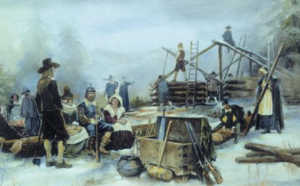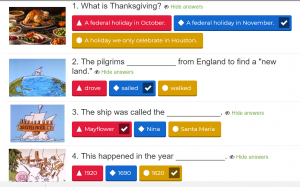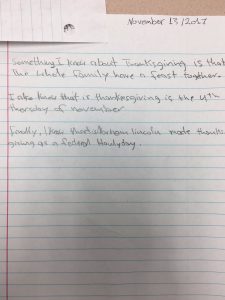It is about to be Thanksgiving in The USA. I offer you these ideas with Thanksgiving as the example but you could adapt them to any holiday coming up in your part of the world. ** The Week 2 Book Study Questions are at the bottom of this post. Please look at the links for more resources for week 2!
Holidays are a great opportunity to help students build background for history and culture of their new countries.
I found great Thanksgiving resources where I always find good resources. I look to Larry Ferlazzo because I know he will have a “Best of” list going. Sure enough, here it is !
One of my goals for this lesson was to help students understand why we celebrate with a feast. I also wanted them to be familiar with what modern day traditions are, and I also wanted to give them some background for US history in terms of how and why our country was founded.
Like some folks, I am conflicted about how we teach this history. I appreciate that Larry offers resources for the uncricital version but offers many resources that help us teach the perspective of the Native Americans at this link: Larry Ferlazzo, larryferlazzo.edublogs.org
So from the resources, I took information to create a Kahoot: https://play.kahoot.it/#/k/b7e993c8-9cab-44c8-8a77-46ff9fd06494
We watched the video below first. Also, when I play the Kahoot, I am teaching and explaining through the Kahoot. Then we play again quickly to see what they remember. It was very successful and allowed us to do some great shared writing I show below.
My reading class is more advanced with English and most have been here through one Thanksgiving. We used the following video and this Kahoot for the Intermediate class:
We also discussed some of the idioms and phrases in the video. Mostly, I wanted to be sure they knew about this youtube channel and how to use it for self study. I love the closed-captioning and the scrolling vocabulary and pictures.
Larry’s list pointed me to http://www.elcivics.com/ which I know I will use to help preteach other social studies concepts. I printed the writing page but offered the students some English sentence frames.
Thxgiving for ESL Ss?
Of course @Larryferlazzo has a “Best resources for teaching abt Thxgiving” list. https://t.co/8UEvGIKctP
I’m using one from https://t.co/Ei2URnnvC5
esl #esol #TESOL #ellchat pic.twitter.com/XPzCAsIRnU— Carol Salva (@MsSalvac) November 13, 2017
During the Kahoot, my students had questions about how Squanto spoke English. (If your students don’t ask, you can lead them to consider this interesting fact) This is a great lead-in to the next part of this lesson where we discuss the Native Americans’ perspective. We use this worksheet from www.elcivics.com which helps me explain how Squanto speaks English and his life as a slave:
 Loading...
Loading...
My intermediate students did a roving paragraph at the end of class. This is a picture of what a SIFE student who only spoke Arabic last year created quickly during the roving paragraph activity. Of course, there was a lot of oral language practice as they changed partners multiple times.Here is a great blogpost by Kirsten Foti on Roving Paragraph!
I hope you and your students have a wonderful holiday break! Thanks for reading and please reach out with any feedback! Also, feel free to join us for the book study below. You can jump in any time!
Stay awesome,
Carol
Twitter Slow Chat Book Study on Boosting Achievement:
I’m a day late, but below are the questions! If this is your first time doing this study, and you want more, please check out all the resources on the WEEK 2 page from our original study. The videos there are in alignment to our focus this week about “Who Are SIFE?”
WEEK TWO QUESTIONS
(Answer some of these, all of these or none of these. We welcome all ideas, reflections & insight!)
- 2Q1) p. 12 “…not all refugee students are SIFE.” Do you think this is a common misconception? How can we help change that perception?
- 2Q2) p. 13 “…teachers need to be prepared to teach language, in addition to content, to maximize English language development.” What is your best advice for content teachers who are new to SIFE?
- 2Q3) p. 15 Every Student Has a Story: These are just some examples of a newcomer backgrounds. Are your students’ backgrounds similar or different than these?
- 2Q4) p. 16-p.18 What are additional ideas for making students feel instantly welcome? Or why do you like some that are mentioned here?
- 2Q5) Use the QR Code on p. 18 or visit bit.ly/deskolympics to analyze the 2-minute video of Carol’s newcomer classes. There are brand-new classmates, SIFE and also students with special needs in these classes. That said, it took only 15 minutes for the class to be able to rearrange desks in under 30 seconds. Why is this video important? (ie: implications for cooperative learning, classroom culture, expectations for diverse learners, or anything that is significant to you.)
- 2Q6) p. 19-21 only scratch the surface of Culturally Responsive Teaching, a very hot topic in education right now. What would you add to this? Or what part resonated with you and why?
- 2Q7) p. 22-23 Osama is a refugee in his 1st year in US schools. He was not SIFE but he appeared delayed in math, initially scoring at a 7th grade level in placement tests. Update: His math teachers used sheltered instruction, he finished the year passing Pre-Calculus, graduating, and he received scholarships to attend college this fall. How can you use Osama’s story? Could it guide you in your role as you work with ELs, other professionals or any type of learner?
- 2Q8) p. 25 – 31 offer examples of different methods a district, a school or a teacher might use to gather information about newcomers and learners who are SIFE. Are any of these realistic in your role? If not, what other means can you share?
Have you posted to the flipgrid yet? Posts again! We’d love to see you there every week! We can always use that grid to reflect on questions or any thoughts we have about the book or our students. I love how many of us are participating this way. It can seem a little scary but it helps me model exactly what I am asking of my newcomers: Take a risk… it will help your learning!
C J had a great Flipgrid reflection about the different labels and how we need to understand them and then get to know the students!
Here is that video:
And he reminded me that we all liked this video on different labels shared by @RCOeducate:
#newcomers vs #refugees vs #immigrants – what are the distinctions? pic.twitter.com/yAxIRGuyNJ
— RCO Educate (@RCOeducate) July 13, 2017
So glad to be sharing with you guys this week!
Also! This is where you can find me in the next few months:
- #BoostingAchievement slow twitter chat book study Nov 6 – Dec 9. Jump in any time. Repeaters welcome. Find all the questions here: bit.ly/BAstudy17. Answer one or just give us your reflections, connections, booksnaps, etc!
- #TxTESOL4 chat to wrap up the conference Nov 14 at 8pm CT
- Kahoot Interactive PD Livestream Nov 15 at 4:30 pm CT. Attend if you’re in Houston (Ninfa’s on Memorial & Dairy Ashford) or watch from their Facebook page!
- Attending Pathways to Greatness training to Support Newcomers by my mentor Dr. Michelle Yzquierdo, Dec 1, 2017
- Presenting at Region 4 Bilingual/ESL Conference (the students are presenting again!) Dec 15, 2017
- Attending The What’s Working in Texas Conference Jan 25, 2018 #SeidlitzConf
- Presenting at NABE 2018
- Presenting at the Abydos Literacy Conference in April 2018
- March 21 SAVE THE DATE – Using Tech with ELLs Conference in Houston. John Seidlitz and I will present this popular training again!
See you at the Nov 14 th chat! here is a sneak peek at the questions:
#TxTESOL4 ChatQuestion Sneak Peek by Carol Salva
Happy Reading and Reflecting!
Carol




